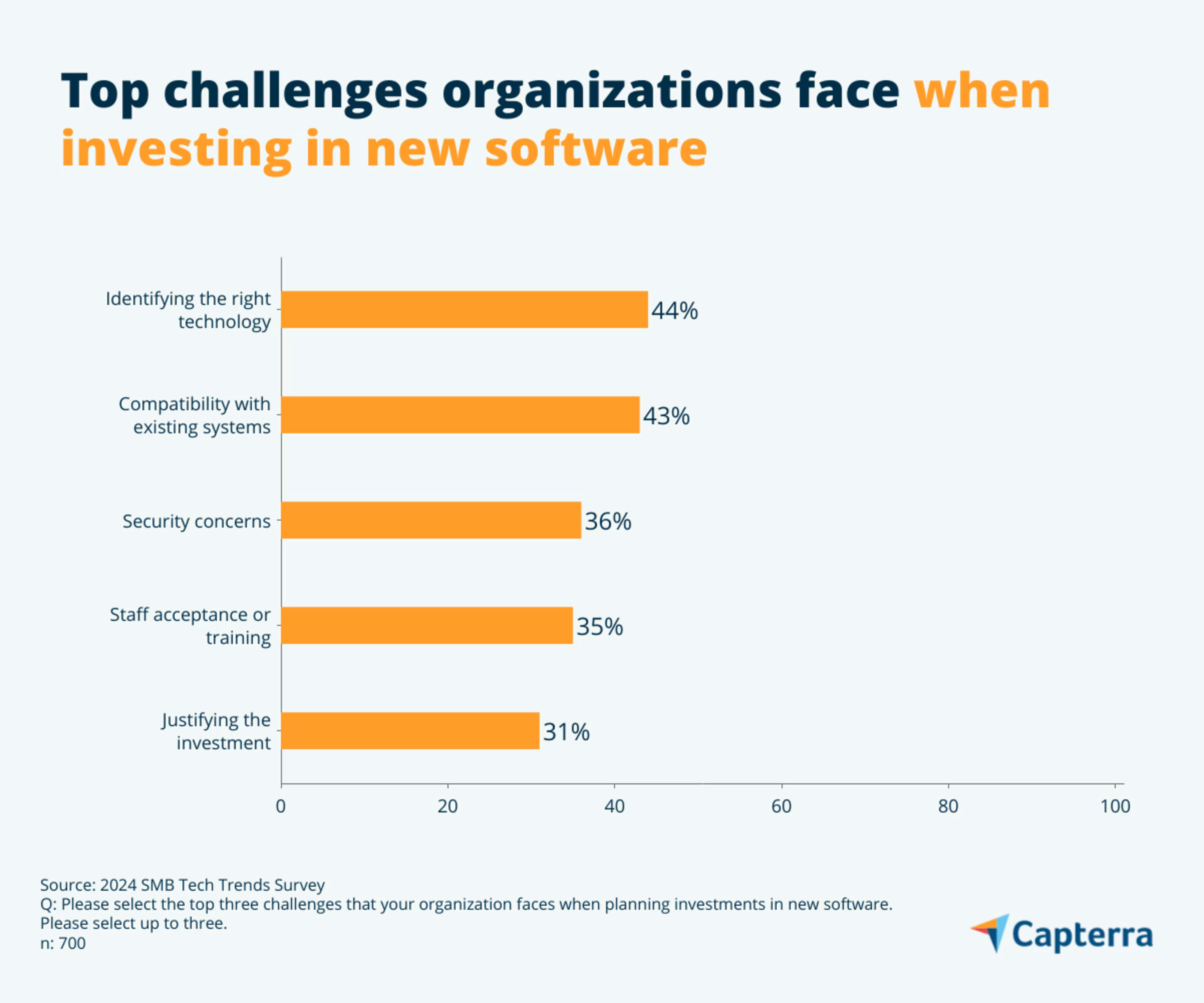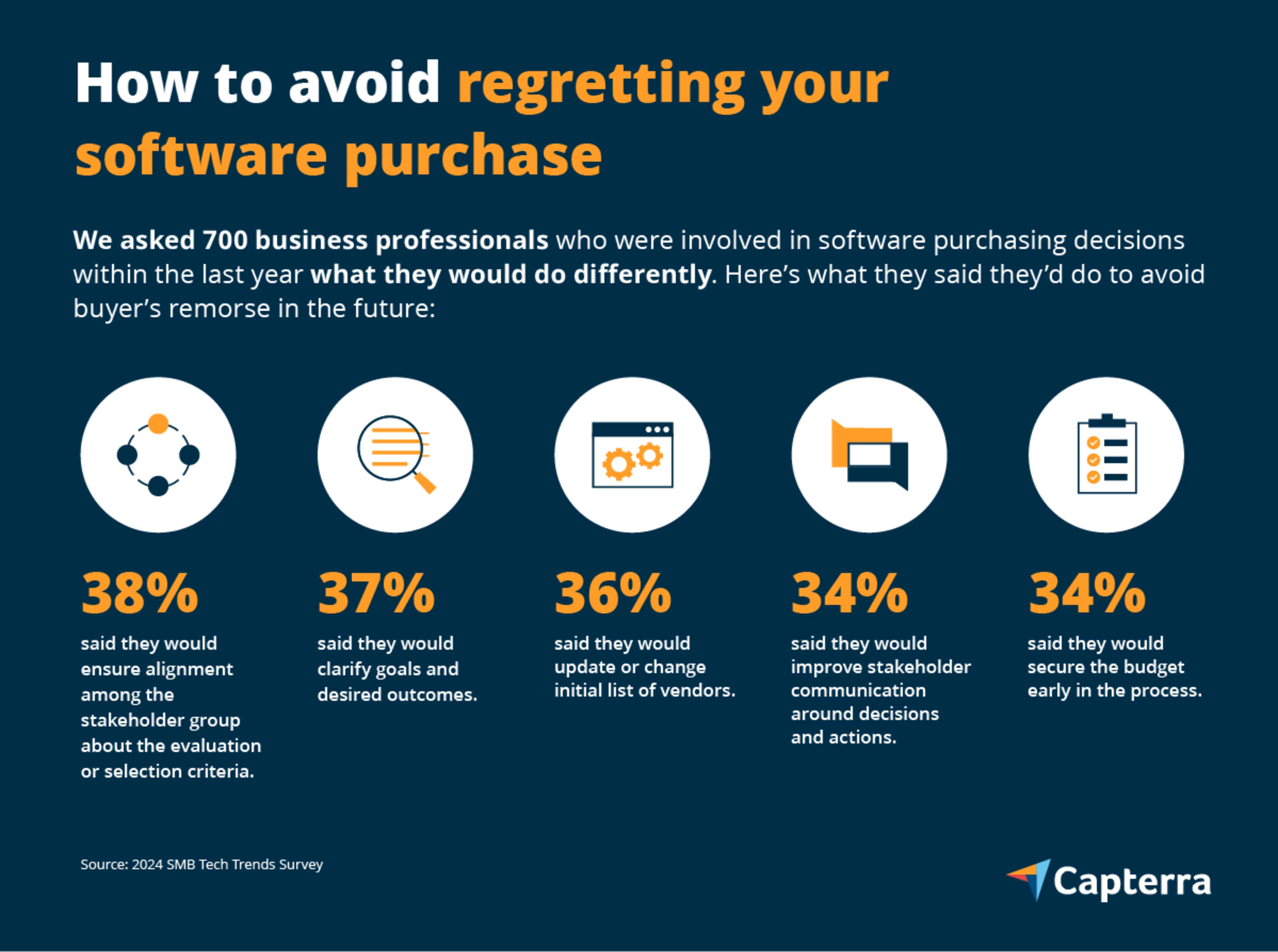At this point, you’ve done all the hard work in identifying your business’s challenges and comparing different software platforms.
You’ve waded through the sea of features each platform offers to finally get to a shortlist of three to five solid software options for your business. You’ve also sat through multiple software demos, asked vendors critical questions about features, data security, usability, training, and customer support, and crunched the numbers to make sure the platform fits both your business’s needs and budget.
This process can be challenging, but all of this work was worthwhile, because you finally found it: the perfect software platform for your business. According to our 2024 SMB Tech Trends Survey*, these steps are among the most challenging for businesses in the software buying process.

Now, you’re preparing for another: Justifying the investment to get everyone else on board—especially the key decision-makers who have the final say.
If you’ve been spearheading or participating in your business’s search for new software, the next step of presenting your decision to stakeholders can feel intimidating. After all, you’ve already put in so much work and believe in the platform you and your team chose. What if stakeholders say no?
To minimize chances of this happening, make sure your business case presentation is as strong as possible and addresses ways you’ve mitigated against buyer’s remorse. In this article, we’ll walk through the different aspects of a solid business case presentation that will get stakeholders on board with your decision. Open our business case presentation template, and fill it out along the way.

1. Clearly state the obstacle you’re trying to address
According to our 2024 SMB Tech Trends Survey, the second most common change software buyers state they will make in their future software selection process is to clarify goals and desired outcomes to avoid buyer’s remorse for software purchases.
At the very beginning of the presentation, let stakeholders know what problem you’re seeking to solve. What issues will the new software address?
For example, perhaps you’ve noticed that your sales team has had difficulty keeping track of leads and client information. This can lead to misplaced contact information, missed leads opportunities, and ultimately, lost revenue for your business.
Stakeholders care about challenges that inhibit business growth, hinder productivity, and lead to unnecessary revenue losses. By stating up front the challenge you’re addressing, you spark their interest, keep their attention, and increase chances of them signing off on your software choice.
2. Introduce the software platform you’ve chosen
Briefly introduce the software platform you’ve identified as the solution for your business obstacle.
For example, if your sales team has been having difficulty keeping track of leads and client information, you could inform stakeholders that you decided to go with a CRM platform. In the presentation, you could say, “This platform will allow our sales team to find and save important client information in an easily accessible place, keep up-to-date records on progress with new leads, and automate follow-up emails.”
By introducing the obstacle you’re addressing and immediately following up with a possible solution, you’re setting your software buying team up for success.
3. Show why this matters for your organization
Now is your opportunity to expand on the platform you chose for your business. Show how this software purchase will help your team meet long-term goals and use specific examples and quantifiable metrics where possible.
For example:
Having customer information in a centralized place will allow account managers to implement a proactive process for retaining existing clients.
The sales team will be able to institute a more rigorous process for following up with potential leads.
The leadership team’s visibility into the progress of our quarterly sales will immediately improve, allowing for more insightful business decisions.
4. Get team buy-in from stakeholders
According to our survey, one of the top five changes survey respondents said they would make in their software selection process to avoid buyer’s remorse in future purchases is to improve stakeholder communication around decisions and actions (34% of respondents).
In the software buying process, stakeholders are the people who can help you make a decision on which software solution is best for your business. They are your sidekicks and can help strengthen your business case presentation.
Stakeholders generally fall into three categories:
Users
Enablers
Key decision-makers
Who are software users?
Who are the software users at your business?
Often, the answer is "everyone," but what does that really mean? You should gather a few different people from each of the following categories to ensure you're getting an accurate read on the needs of software users in your business.
Direct users: These are the people who will interact with the software directly every day. Their buy-in is paramount because in the end, you can have the best software in the world but it doesn't matter if no one wants to use it. Recruit two to three people to give opinions on your shortlist and get their opinions in writing. You'll want those for when you build your strong business case.
Indirect users: Indirect users are people who won't use the software every day but are directly affected by the products or processes it impacts. Their workflows depend on the software.
During your presentation, include quotes from software users about specific pain points they experience. For example:
“Without a system for tracking leads, it’s hard for me to remember who I’ve reached out to and who I haven’t.” - Direct user
Twenty percent of potential clients have not received follow-up communications, which represents X amount of lost revenue.
Who are software enablers?
These are the members of your superhero support team that help grease the wheels of software adoption. You want their buy-in because they will get the users, and sometimes the decision-makers, on board.
Mid-level managers: Not quite the final decision-makers, managers of teams that use software can let you know the pain points their team is encountering, as well as any expected push-back from members once you choose the final software solution.
Implementation team: Probably the most important software enabler is the person, or persons, who will stand up your software solution. If you have a tech team, let them weigh in on your software solution. They'll let you know if there are any technical aspects of your business that won't mesh well with any product, or any tech obstacles to anticipate.
For example:
After speaking with our IT team, this new software will integrate seamlessly with all of our existing platforms.
Who are the software decision-makers?
These are the people you’re presenting to. They were not a part of the software selection process, but will have the final say over the choice and investment.
Legal entities: If you have software that will change how you interact with clients or their data, it's best to run your choice by your legal representative early on in the process. You want to make sure your software choice isn't going to negatively affect your responsibilities to the customer.
Finance: This is where you win over the accounting manager. Accounting will want to know how much the software costs: For implementation, annual subscription costs, price increases when there are changes in circumstances (like adding more users), and, to be blunt, the bottom line. Come prepared with that information, and you'll have a better chance at buy-in from accounting.
Business leadership: To get your boss and others on the leadership team on board with your software selection, use our sample business case below to organize your findings and plans for involving other stakeholders.
You’ll likely be presenting to business leaders for the first time in this presentation, but you’ve probably already consulted with your business’s legal team. If you have, include takeaways from that conversation.
For example:
The IT and legal teams have approved this software selection.
5. Walk stakeholders through the software evaluation process
While you and your team have been thinking about this software platform for months, this will be the first time business leadership hears about it. This means you need to condense months worth of work into a concise and snappy summary.
Even though this can mean additional work, this step shouldn’t be skipped: The top change survey respondents said they would make in their software selection process to avoid buyer’s remorse in future purchases is to ensure alignment among the stakeholder group about the evaluation or selection criteria (38% of respondents).
This overview should briefly list the different options you evaluated and how you landed on the software you’re proposing now. Include things such as the number of platforms you had on your shortlist, resources you used in the evaluation process, and who you consulted with.
For example: “We evaluated three different CRM solutions: A, B, and C. We researched their different functionality, attended product demos, read user reviews, weighed the costs against our budget, and consulted with X internal stakeholders to determine which software best aligned with our business needs.”
6. Explain why you chose your specific software
What made the software you chose standout among the others on your shortlist? Perhaps the software you chose was better suited for the number of users you have in mind, or perhaps it simply had the specific features you needed to address the business challenge. Perhaps it is the best option for automating specific manual processes, or offers the most overall business value.
Whatever the case may be, let stakeholders in on your thought process and highlight key features the platform offers. When possible, link them back to the challenges you identified at the beginning of the presentation.
For example:
Centralized communications: Account managers can correspond with clients from within the platform.
Robust client profiles: The sales team can add notes and update the status of potential leads.
Dynamic report builder: Monthly progress reports can be generated inside the platform and shared directly with leadership.
7. Introduce implementation process and timeline
Now that you’ve walked the stakeholders through the process up to this point, you can focus on future steps, if business leaders give the green light on the software platform.
Include information about your plan for integrating the proposed software into your current tech stack, pricing plans, budget considerations, and onboarding the team.
Anticipate questions about timing by providing stakeholders with a timeline that details key milestones such as contract start date, software training kickoff, phases of implementation, when you think the team will be fully onboarded, and when you think the software will be fully implemented.
Try to secure the budget for the software purchase as soon as possible: One of the top five changes survey respondents said they would make in their software selection process to avoid buyer’s remorse in future purchases is to secure budget early in the process (34% of respondents).
Use our free business case template to present with confidence
Making a compelling business case presentation can feel overwhelming. But by taking it one step at a time and using it as an opportunity to share what you’ve learned in the process, you can get stakeholders on board, get the signoff you need to make the investment decision, and implement new software knowing you’ve taken steps to avoid buyer’s remorse and feel confident about your new platform.
For more guidance on finding your business’s software match, check out the following resources:
